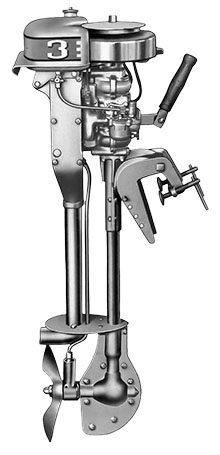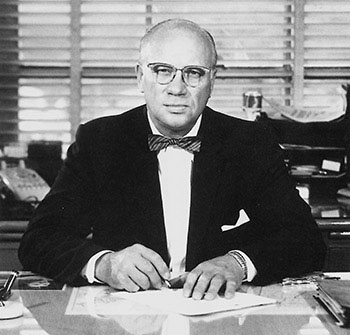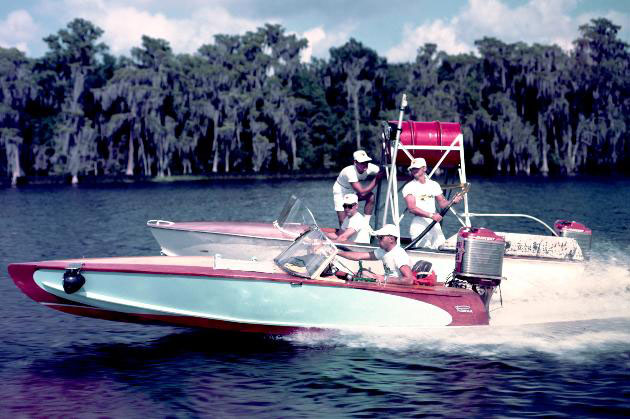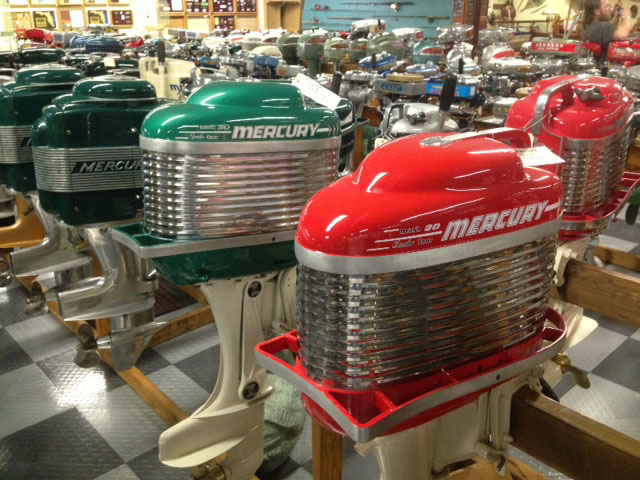
This year marks the 75th anniversary for Mercury Marine. In recognition of that milestone, I dedicate this column to the company that has backed me since the beginning of my career.
As long as I can remember, Mercury has been a dominant player in watersports. Their engines have set hundreds of speed records, as well as propelled countless anglers to victory on every major fishing circuit, both in fresh and saltwater. And much of this success is due to the relentless drive of one unique individual — Carl Kiekhaefer, the founder of Mercury Marine.
Because of Kiekhaefer’s never-ending desire to be the best, Mercury established a long list of industry firsts — including the first enclosed lower-unit housing, impeller-driven cooling system, thru-hub exhaust system and countless other innovations.
Through the dedication and drive of Kiekhaefer and his loyal employees, Mercury Marine became the most celebrated outboard manufacturer in history.
In The Beginning
Kiekhaefer’s first exposure to the marine industry came in 1927, when he was hired as a draftsman by Evinrude Motors. The stint didn’t last long, however. Within three months Kiekhaefer was fired, apparently because he was too difficult to work with.
It wasn’t until twelve years later when Kiekhaefer would, once again, try his hand at outboard motor production. With the help of his father, he purchased the Cedarburg Manufacturing Company of Wisconsin — makers of Thor Outboards.
Carl’s interest in the company wasn’t for its outboard motors, however. He actually wanted to build magnetic separators, as that was his background. But as fate would have it, those plans were quickly shelved.
Upon taking over the business, Kiekhaefer was dealt an immediate blow. Chain-store giant Montgomery Ward had just cancelled a pending order for several hundred Thor engines, claiming they were unfit for resale. Already assembled and ready for shipment, Kiekhaefer had no option but to unpack and rebuild the malfunctioning motors in the hope he could save the deal.

Wasting no time, his team disassembled the defective engines, then redesigned and replaced all of their weaker parts. The effort turned out to be costly and time consuming, but Kiekhaefer was able to convince Montgomery Ward to follow through on the original purchase.
As time passed, the Thor’s reputation for reliability grew, and Montgomery Ward increased its distribution. Soon after, Western Auto Stores approached Kiekhaefer to build their Wizard brand of outboards. By that point, any thoughts of producing magnetic separators had been forgotten. Kiekhaefer was now in the outboard business!
Wartime Woes
Observing the success of his two major clients, Kiekhaefer decided it was time to market his own line of outboards, and so, the “Mercury” brand was born.
Unfortunately, shortly after its introduction, World War II broke out. The United States was now embroiled in a battle with Germany, Italy and Japan, and as a result, stiff government restrictions were imposed on raw materials — the most important of which was aluminum, the primary material used in producing outboard motors.
Aluminum was also critical to aircraft production, which became an immediate priority. Although Kiekhaefer petitioned the State Department to lift the restrictions, his appeals were denied. The company’s future was in peril. Meanwhile, Evinrude (Kiekhaefer’s chief rival) had won its petition and was granted access to ample stocks of aluminum. That was salt in the wound for Kiekhaefer.
Eventually salvation came in the way of government contracts. Small businesses across the country were enlisted to build machinery and arms for various branches of the military. Mercury’s role was to produce small engines for chainsaws, generators and drone aircraft. Interestingly, the drone engines were constructed from the same power-heads used to build outboards.
It was a lean time, but government contracts kept the company afloat. After the war ended, returning soldiers brought a boon to the U.S. economy, and recreational sporting equipment experienced a sharp increase in sales. In response to demand, Kiekhaefer introduced numerous new models of outboard engines, and as the numbers grew so did horsepower.

Speed & Endurance
Kiekhaefer always had a fascination with speed. His first love was stock cars, but later he became obsessed with boat racing. And it was this obsession that would ultimately separate Mercury from its competition.
With the help of Charles Strang, a boat racing journalist, and Ted Jones, known at that time as “the fastest man on water,” Kiekhaefer developed Mercury’s new racing division. The company acquired properties in Florida, including a saltwater test facility in Sarasota and an obscure freshwater lake near St. Cloud.
Eventually referred to as “Lake X,” Mercury used this facility for much of its secretive testing — including a special project called “Operation Atlas.”
In an ongoing battle with Outboard Marine Corporation (OMC), negative campaigns were frequently launched by both sides. It all came to a head, however, when Kiekhaefer suspected OMC of spreading the slanderous slogan, “fast but won’t last” to describe Mercury outboards.
Determined to dispel any public concerns about the durability of Mercury engines, Kiekhaefer ordered his team to conduct an endurance test using the Mercury 75.
He insisted a distance matching that of the Earth’s circumference (25,000 miles), be achieved by not one, but two test boats. For verification, he sought out the highly reputable United Sates Auto Club (USAC), and on September 11, 1957, the two boats left the docks at Lake X for what turned out to be a 34-day marathon.

Testing wasn’t without mishap. There were numerous mechanical issues to overcome, such as bad fuel and fouled plugs. But what proved most devastating was the loss of a driver during a nighttime run. Apparently he fell asleep at the wheel and crashed head-on into a stand of cypress trees.
Despite these setbacks, both Mercury 75-powered boats eventually reached the finish line, making Operation Atlas a huge success. Kiekhaefer’s promotional department ran a worldwide campaign that included USAC’s verification of the results. Sales boomed, and the words “fast but won’t last” were buried beneath a mountain of positive press.
Mercury Rising
In 1961, Mercury was acquired by Brunswick Corporation — a giant in the recreation industry. The merger provided Kiekhaefer the financial stability and resources to expand. Nine years later, he relinquished control of Mercury to form Kiekhaefer Aeromarine Motors, at which point outboard and offshore powerboat racing became his focus.
In 1973, a young driver by the name of Earl Bentz joined Kiekhaefer’s racing team. Existing members included Bill Seibold and Reggie Fountain. Referred to as the “Black Angels”, the three went on to win countless races, establishing many new speed records in the process. Today these men are considered legends in the marine industry.

Although significant emphasis was placed on racing at the time, Mercury never turned its back on fishing. The Bass Anglers Sportsman Society (B.A.S.S.) was beginning to glamourize the sport and it wasn’t long before competitive anglers developed the same need for speed.
In lockstep with powerboat racing, bass boats also evolved into high performance watercraft, and the engine most anglers relied on was the Black Max.
That’s true today as well. In maintaining its position, Mercury sends a team of highly skilled technicians to all major North American fishing competitions — both fresh and saltwater. The company also touts one of the largest pro-staffs in fishing.
From top-level pros to guides and charter captains, these individuals demonstrate the same characteristic drive and tenacity as the man who started it all …75 years ago.
—
If you’d like to learn more about the history of Mercury, check out The Legend of Mercury by Jeffrey L. Rodengen. It’s a fascinating account of Carl Kiekhaefer and the company he built and served as a primary reference for this column. Rodengen’s Iron Fist is a biography of Kiekhaefer.

